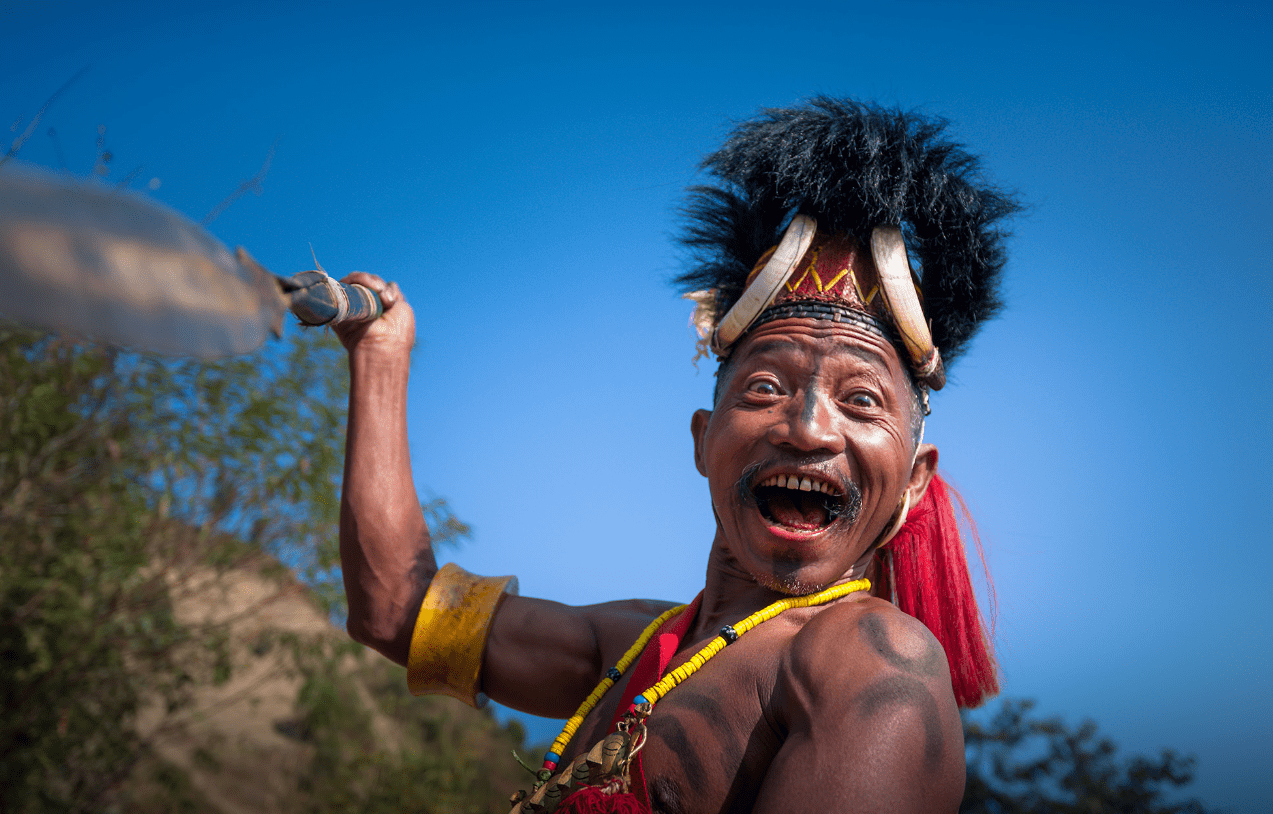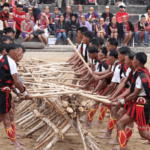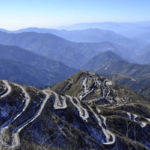Some consider it the most vibrant celebration in Northeast India, affectionately dubbed the Festival of Festivals. We’re referring to the Hornbill Festival in Nagaland, an exceptional introduction to the traditional and cultural tapestry of the region. Indeed, our Festivals of India series would be incomplete without highlighting this stunning celebration of Nagaland’s life, culture, cuisine, and tribes.
What is the Hornbill Festival?
The Hornbill Festival is a ten-day cultural extravaganza that takes place annually from December 1 to 10. This festival aims to celebrate and preserve the rich, diverse culture of the Naga tribes. It’s a land steeped in folklore and tales of brave warriors and hunters, immortalized in local songs. The Hornbill Festival is a tribute to all these aspects and more.
The festival honors the 16 tribes of Nagaland through music, dance, art, cuisine, traditional sports, and more. Initiated by the Government of Nagaland, it began in the year 2000.
Over the years, the Hornbill Festival has become a prominent showcase of Nagaland’s cultural heritage, drawing significant attention to the region and boosting tourism.
Witnessing this festival is an absolute delight, offering a chance to experience all the tribes of Nagaland in one place. You can observe their traditional war dances, folk music, and unique customs.
The Colorful Tribes of Nagaland
We’ve heard about Nagaland’s 16 tribes, each distinct in customs, language, attire, and culture. These tribes include:
- Angami
- Ao
- Chakhesang
- Chang
- Kachari
- Khiamniungan
- Konyak
- Kuki
- Lotha
- Phom
- Pochury
- Rengma
- Sangtam
- Sumi
- Yimchunger
- Zeme-Liangmai (Zeliang)
Additionally, there are various sub-tribes, each with its own dialect, showcasing Nagaland’s remarkable linguistic and cultural diversity.
Why is the Hornbill Festival Celebrated?
The Hornbill Festival is named after the hornbills, revered birds featured in Naga folklore and songs. Historically, these birds were nearly driven to extinction due to hunting practices, with their feathers used in traditional headgear.
Efforts to encourage the use of synthetic feathers instead of real ones were initially unsuccessful. However, over time, there has been a growing awareness about wildlife preservation among the local communities. Dialogues within the Naga tribes on hornbill conservation have contributed to this shift.
The festival, which begins on December 1, coincides with Nagaland Formation Day, making it an apt celebration. Organized by the state government, it unites the various cultures and festivals of the 16 Naga tribes on one platform.
Initially featuring traditional games, folk songs, and dances related to wars and harvests, the festival has evolved into a grand event attracting international visitors.
Where is the Hornbill Festival Celebrated?
The Hornbill Festival takes place at Kisama Heritage Village, situated about 5 km from Kohima, the capital of Nagaland. Shared taxis are available from Kohima to Kisama.
Performances generally start around 9:30 AM each day. Tickets can be purchased at the entry gates, where security checks are conducted before entering the festival grounds.
Where is Nagaland?
Nagaland is located in the northeast of India, part of the Seven Sister States. The name “Nagaland” means the land of the hospitable and friendly Nagas, representing the 16 tribes residing there.
The state shares borders with Assam, Arunachal Pradesh, Manipur, and Myanmar. Known for its picturesque green valleys, winding paths, serrated ridges, and dense evergreen forests, Nagaland is a mountainous region.
What to Do at the Hornbill Festival?
The Hornbill Festival is Nagaland’s largest and most vibrant celebration, offering a plethora of activities. The daily events usually begin around 9:30 AM, with various performances and activities changing each day. Spending 3 to 4 days at the festival will provide a comprehensive experience. Here’s what you shouldn’t miss:
Visit the Morungs
Exploring the Morungs is a highlight of the Hornbill Festival. These community spaces, where young boys are educated about their tribe’s history and skills, are particularly photogenic in the early morning before performances start. Remember to ask for permission before taking photos, as the right to photograph is not always explicitly granted.
What are Morungs?
Morungs are traditional community centers in Naga villages where young boys learn about their tribe’s heritage, arts, and life skills. These spaces serve as dormitories and training grounds, where boys are taught about warfare, hunting, and cultural values. At the festival, temporary Morungs are set up by each tribe, showcasing their lifestyle and traditions through traditional huts made from bamboo, hay, and wood. Each Morung is adorned with tribal weapons or animal symbols, and provides insights into the tribe’s culture and community.
Have Conversations with the Different Tribes
Engage with the various tribal communities at the Morungs. Ask them about their lifestyle, culture, and historical practices. The first day of the festival is ideal for such interactions as cultural performances typically start in the evening, creating a lively atmosphere for conversation.
Enjoy the Cultural Performances
The festival’s cultural performances are a major attraction. Each tribe performs traditional dances and songs, reflecting various aspects of their culture, such as festivals, harvests, and historical events. The colorful attire, intricate headgear, and energetic performances offer a captivating experience. Additionally, dances from other northeastern states are also featured, providing a diverse cultural showcase.
Taste Traditional Naga Food
Food plays a significant role in the festival. Sample traditional Naga dishes prepared by the tribes. At the Morungs, you can enjoy local cuisine while interacting with the community. Food stalls offer a variety of dishes, including pork, chicken with bamboo shoots, rice cakes, and pickles. Vegetarian options are available, and food competitions add to the excitement.
Drink Rice Beer
Complement your meal with local rice beer, a popular and affordable beverage at the festival. Despite alcohol restrictions in Nagaland, rice beer is a permissible and enjoyable part of the celebration.
Music & Rock Concerts
Nagaland is renowned for its rock music, and the Hornbill Festival features rock performances. The Hornbill International Rock Contest, now known as The Great Hornbill Rock, showcases bands from across India. Regular concerts are held at Kisama and other venues in Kohima.
Shop for Souvenirs
Explore the Morungs for unique handicrafts and jewelry. Nagaland’s vibrant bead jewelry and traditional shawls make for excellent souvenirs. Shawls often carry symbolic patterns representing social status and tribe.
How to Reach Kohima, Nagaland
Dimapur, not Kohima, is the gateway to Nagaland with its airport and railway station. From Dimapur, you can travel to Kohima by taxi or bus.
By Flight
Dimapur (DMU) has direct flights from Kolkata, Guwahati, Imphal, and New Delhi.
By Train
Trains from Guwahati, Sealdah, or New Delhi can take you to Dimapur. The New Delhi-Dibrugarh Rajdhani Express is a convenient option.
By Bus
An overnight bus from Guwahati to Dimapur is the most economical choice, though it involves a bumpy ride. From Dimapur, taxis or buses can be used to reach Kohima.
How to Reach Kisama Heritage Village (Hornbill Festival Venue)
Shared and private taxis are available from Kohima to Kisama Heritage Village, about 12 km away. Buses and shared sumos also connect to Kisama from Network Bus Station.
How to Get an ILP for Nagaland
Indian visitors to Nagaland require an Inner Line Permit (ILP). Obtain it from the Deputy Resident Commissioner Offices in New Delhi, Kolkata, Guwahati, or Shillong, or at Dimapur on arrival. ILP applications can also be submitted online. You’ll need a passport-sized photo and proof of identity and residence. The permit is valid for 15 to 30 days.
Where to Stay During the Hornbill Festival
Kohima and Kisama offer various accommodation options. During the festival, camping at Kisama provides a convenient and budget-friendly choice. Sturdy tents are set up for tourists, and while basic, they offer necessary amenities. Other options include homestays and guesthouses in Kisama.
Tentative Hornbill Festival Itinerary
- Day 1: Travel from Dimapur to Kohima
- Day 2: Full day at the Hornbill Festival in Kisama
- Day 3: Additional day at the festival (recommended if time permits)
- Day 4: Explore Kohima and Khonoma
- Day 5: Dzukou Valley Trek
- Day 6: Return to Kohima
What Else to Explore During the Hornbill Festival?
While the Hornbill Festival is a major attraction, Nagaland offers many other interesting sites to explore.
Exploring Kohima
Kohima, the capital of Nagaland, is a charming town with a rich history and vibrant culture. It’s worth spending some time exploring its key attractions:
- Kohima War Cemetery: A solemn and beautifully maintained site commemorating the soldiers who lost their lives during World War II. The cemetery offers a peaceful environment and historical insights into the region’s wartime past.
- Kohima Cathedral: An impressive structure with a striking architecture that stands as a testament to the Christian influence in Nagaland. It’s a serene place for reflection and offers panoramic views of the surrounding landscape.
- Nagaland State Museum: Located in Kohima, this museum provides a comprehensive overview of Nagaland’s cultural heritage. It features exhibits on tribal artifacts, traditional costumes, and historical items.
Khonoma Village
Just a short drive from Kohima, Khonoma is renowned for its traditional Naga lifestyle and conservation efforts. Known as the “Green Village,” it’s a model for sustainable living and eco-tourism. You can explore its:
- Traditional Naga Homes: Experience the unique architecture and community life of this historical village. The houses are built with local materials and showcase traditional craftsmanship.
- Conservation Initiatives: Khonoma is a pioneer in wildlife conservation, particularly for the endangered Blyth’s Tragopan. Learn about the village’s efforts to protect its natural environment and wildlife.
Dzukou Valley Trek
For nature enthusiasts and adventure seekers, the Dzukou Valley Trek is a must-do. This scenic trek offers:
- Stunning Landscapes: The valley is known for its lush greenery, rolling hills, and vibrant flora. The trek provides breathtaking views and a chance to immerse yourself in nature.
- Flora and Fauna: Dzukou Valley is home to a diverse range of plant species, including rare orchids, and various bird species. It’s an ideal location for wildlife enthusiasts and photographers.
Practical Tips
- Best Time to Visit: The Hornbill Festival is held from December 1 to 10. The weather is relatively mild during this time, making it an excellent period for outdoor activities and exploration.
- Travel Tips: Ensure you have all necessary permits and travel documents before your trip. It’s also wise to book accommodations well in advance due to high demand during the festival period.
- Local Etiquette: Respect local customs and traditions. Engaging with the tribal communities in a respectful manner will enhance your experience and foster positive interactions.
By immersing yourself in these activities and exploring the local culture, you’ll gain a deeper appreciation of Nagaland’s heritage and the vibrant celebrations of the Hornbill Festival.
Feel free to adjust or let me know if there’s anything else you’d like to include!


